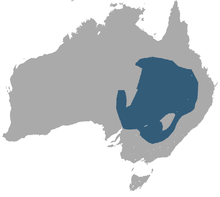Southern flat head pouch mouse
| Southern flat head pouch mouse | ||||||||||||
|---|---|---|---|---|---|---|---|---|---|---|---|---|

Southern flat head pouch mouse ( Planigale tenuirostris ) |
||||||||||||
| Systematics | ||||||||||||
|
||||||||||||
| Scientific name | ||||||||||||
| Planigale tenuirostris | ||||||||||||
| Troughton , 1928 |
The southern flat-head pouch mouse ( Planigale tenuirostris ), also known as the pointed-nosed flat-head pouch mouse , is a very small member of the predator family . It occurs in the interior of eastern Australia.
features
The southern flat-head pouch mouse has a head-trunk length of 5 to 7.5 cm, a 5 to 6.5 cm long tail and weighs 4 to 7 g. The head is flat and triangular, with a pointed nose. The eyes protrude like pearls. The ears are small, round and close to the head. The silky fur is rust-brown on the back and whitish on the belly. The tail is thin and about as long as the head and torso. The torso and hind legs of the animals are extremely flexible and allow them to slip through the narrowest gaps. The southern flat head pouch mouse is confusingly similar to the northern flat head pouch mouse ( Planigale ingrami ), but is significantly heavier than this (average weight 5.5 g vs. 4.6 g). Their head is less flattened, the muzzle is narrower, and the incisors and premolars are larger than those of their relatives. The animals have three premolars on each side of the upper and lower jaw.
habitat
The southern flat-headed pouched mouse lives in open grasslands, in tussock grasslands , in bushland and in dense vegetation on the banks of temporary streams. The floors are dry and mostly loamy, sometimes rocky and especially with different fox tail plants as maireana aphylla , Tecticornia medullosa , the Log plants Atriplex nummularia and Atriplex vesicaria covered. In the south of the Flinders range it is also found in the Mallee and in high forests with populations of Eucalyptus goniocalyx and Eucalyptus leucophloia . In the north of the Flinders range, it lives in hilly grassland with prickly head grasses ( Triodia ). In the desert areas of New South Wales it comes together with Giles Panhead bag mouse ( P. gilesi ) and the Dickschwänzigen Schmalfußbeutelmaus ( Sminthopsis crassicaudata before). The animals probably use a different microhabitat . The northern flat head pouched mouse is found mainly in areas with taller plants.
Way of life
The southern flat-headed pouch mouse is nocturnal and can be active at all hours of the night in summer. In winter, when the night temperature can drop to values around freezing point, the activity time is limited to the hours before sunrise and after sunset. They spend around 70% of their active time underground. 27 males examined for their movement patterns covered an average of 172 meters (max. 600 m) during their active time. In eight females examined, it was only 100 meters (max. 550 m). They sleep through the day and the inactive time of the night or rest in self-dug caves in the ground, which, depending on the nature of the ground, can be 30 cm to 2 meters deep. On average, they sleep or rest for more than 21 hours a day. They spend their rest periods alone or, especially in winter, with several people. During the cold season they can also fall into a torpor and reduce metabolic and energy expenditure by 30 to 50%. The southern flat-head pouch mouse feeds on beetles, crickets, moths, grasshoppers, spiders, and millipedes. When foraging for food, it sticks its wedge-shaped head in fallen leaves or between grass roots. It can overwhelm prey larger than itself and kill them by biting the head and body. To eat larger prey, the animals often sit on their hind legs while holding their food with their front paws. They cover their moisture requirements with food and are not dependent on open water.
Reproduction
The breeding season of the southern flathead pouch begins in late July or early August and lasts until mid-January of the next year. During this period, the females give birth once or twice. The average litter size is 6 pups, but 10 to 12 are also possible. Birth takes place 19 days after mating. At birth, the young are 3 mm long and hairless. Immediately after birth, they suck on a teat in the pouch for a period of 40 days. They spend the rest of the time up to self-employment in a nest. They open their eyes after about 51 days and they are independent after about 95 days. Only 15% of the southern flathead pouch mice live to be more than two years old.
Danger
The IUCN classifies the southern flat-head pouch mouse due to its large distribution area and its frequency as Least Concern . The stock fluctuates depending on the frequency of rainfall.
Individual evidence
- ↑ a b c d e Andrew Baker: Family Dasyuridae (Carnivorous Marsupials). Pp. 328-329 in Don E. Wilson , Russell A. Mittermeier : Handbook of the Mammals of the World - Volume 5. Monotremes and Marsupials. Lynx Editions, 2015, ISBN 978-84-96553-99-6
- ↑ Planigale tenuirostris in the endangered Red List species the IUCN 2016 Posted by: Ellis, M., van Weenen, J. & Burnett, S., 2015. Accessed June 17, 2018th
